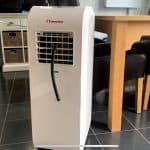Offering unrivaled convenience and mobility, portable air conditioners are becoming increasingly popular methods for cooling indoor spaces. Venting the AC is an important part of using it effectively.
Can you vent a portable air conditioner into the attic?
It is possible to vent a portable air conditioner into an attic, however, this depends on the size. Smaller attics will heat up quickly due as hot air is vented from the portable air conditioner, which can lead to your home getting even warmer. Venting the air conditioner in a larger attic is likely to be less problematic.
There are other variables to consider which will also impact the process of venting your portable air conditioner into the attic. The specific type of AC unit in question, coupled with the layout of your attic, will play a large role.
I’ll cover every aspect in detail in the following sections so that you can make the right decision when venting your portable air conditioner.

Can You Vent a Portable Air Conditioner Into the Attic?
Venting a portable air conditioner is relatively straightforward, but it’s important to ensure that you do it correctly to avoid any issues arising.
Air conditioners work by extracting the hot air from a room, causing the over temperature to drop. This hot air then needs to be directed out of the room, ideally outside of the building.
If the portable air conditioner is not vented appropriately, the hot air will be reintroduced into the space, rendering the process ineffective.
Most portable air conditioner manufacturers advise you to vent the hot air outside, as this ensures that it doesn’t heat the inside of the building. However, this may not always be possible and therefore you may be considering an alternative method.
If your house has an attic, this may seem like a logical palace to vent your portable air conditioner into. Attics are usually isolated from the rest of the house, and because heat rises, there’s less chance of the hot air coming back down into the room that you’re attempting to cool down.
- The main issue with venting a portable air conditioner into the attic is that this will inevitably lead to the space getting warmer, as the hot air is deposited. If the attic is relatively small, it won’t take very long for the temperature to rise considerably.
Heating your attic may be preferable to heating the other rooms in your home, but it’s important to remember that this will lead to the entire building’s temperature increasing as the structure and walls of the attic are exposed to the hot air from the ventilation process.
Larger attic spaces will take longer to heat up, and are therefore a better option for venting your portable air conditioner into. The larger the attic is, the more hot air it will take to warm up, and the longer it will take for the walls and surfaces to increase in temperature.
If you’ve invested in a portable air conditioner, you’ll want to ensure that it works to its fullest potential. These devices are designed to cool down a space that is too warm, so if they ultimately result in another room, such as the attic, getting warmer, then this defeats the point of using one in the first place.
Another factor that will impact whether it’s suitable to vent your portable air conditioner into the attic is the type of ventilation it uses. For example, an AC unit with dual-hose ventilation will likely lead to the attic becoming warmer at a faster pace, lessening the cooling effect of the device.
How Far Can You Vent a Portable Air Conditioner?
The ventilation hose that comes with most portable air conditioners is around 6-8 feet. In some cases, this may not be long enough to reach your desired location for venting the hot air out of the unit, particularly if you’re considering the attic.
Thankfully, longer ventilation hoses are readily available and easy to install on the portable air conditioner. This makes it possible to vent the hot air as far as 20ft, or even longer if you opt for a lengthier option.
However, it’s recommended that you keep the length of the ventilation hose as short as possible.
- Once you exceed around 12ft in length, this may result in the hot air not being pushed out by the system with enough force to reach the end of the hose.
A portable air conditioner that has powerful venting systems may be capable of pushing the hot air as far as 20ft, but smaller units are unlikely to facilitate this.
Another issue with using extensive venting hoses is that they’re more likely to bend and possibly kink, which could lead to the hot air getting trapped inside and making its way back down into your room. Overheating of the AC is a risk if this occurs.
It’s best to check the specifications of your portable air conditioner before extending the length of the ventilation hose, to see if this is possible. Most manufacturers will happily respond to any queries if you contact them.
Check out this YouTube video that shows how to effectively vent out of a window.
Can You Vent a Portable Air Conditioner Up A Chimney?
Chimneys can be the perfect solution for venting a portable air conditioner. If your house has a chimney that is no longer used for an open fire, sending the hot air from the AC may seem like a logical thing to do.
In theory, there’s no reason that this shouldn’t work. After all, the original purpose of the chimney was to vent out the hot air that was produced from the fire, so it is perfectly equipped to deal with the lower temperatures produced by a portable air conditioner.
The chimney is also a relatively easy place to feed the ventilation hose from the air conditioner so that it can expel the air out of your house.
This is a much more effective method than venting the AC into the attic, as there’s no chance of the hot air heating the structures of the building and therefore being less effective.
Many portable air conditioner users choose to vent the hot air through a window, but this isn’t the most effective method. If the weather is hot outside, opening a window will allow more heat to come in, limiting the AC’s ability to cool down the room.
A chimney, on the other hand, doesn’t require you to open any windows or let heat into the house. You can simply feed the hose up the chimney, and the heat will rise out and through the opening without being retained.
Before using your chimney to vent the portable air conditioner, you must check there are no blockages that will impede the hose. It might be a good idea to get the chimney serviced and cleaned by a professional.
Some old chimneys may have been sealed if they are no longer used for an open fire, and this would make them ineffective for venting the heat from the portable AC. Providing your chimney is still usable, you should be able to use it for venting without any issues.
Does a Portable Air Conditioner Have to be Vented Outside?
Although there are some potential alternatives such as a large attic, it’s strongly advised that a portable air conditioner is vented outside. This is mainly because the hot air will heat the building if it is reintroduced inside, defeating the point of the air conditioning.
To simplify, the goal of a portable air conditioner is to cool down a room or space inside a building. It does this by absorbing heat from the air, using a refrigerant. A fan mechanism is then used to spread the cool air around the room, lowering the temperature.
As a result of this process, heat is produced within the air conditioner. This heat must be vented through a hose and transported to another location so that it doesn’t go back into the room that has been cooled down.
If the warm air isn’t vented outside, it will simply remain in the room, causing the cooled air to become warm again. This means that the air conditioner can not do its job properly, and you’ll be wasting money on electricity while using it.
Consequently, it’s best to always try to vent the air conditioner outside. The only exception is if you have a large attic that lets the heat out and isn’t insulated.
Related Questions
Can a portable air conditioner be vented into a garage?
Venting a portable air conditioner into a garage is preferable to venting it back into the house, but it will still cause the space to get warmer. When the garage heats up, this may lead to the house’s temperature also increasing.
How can you cool down a room that has no windows?
Portable air conditioners cannot be used in a room with no windows, as there is nowhere for the hot air to be vented. Using another device like a powerful fan, or a vent-less air conditioner could be an alternative.
Are portable air conditioners a fire hazard?
There is a risk that portable air conditioners could become a fire hazard if the temperature gets too hot. This is rare, however, and can be avoided if they are properly maintained and vented.
Portable AC Upstairs or Downstairs?
Check out our article on this subject. You can read it here.




